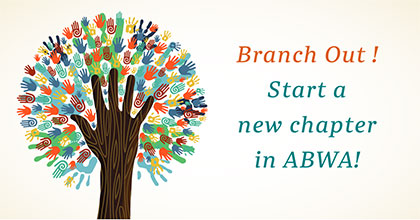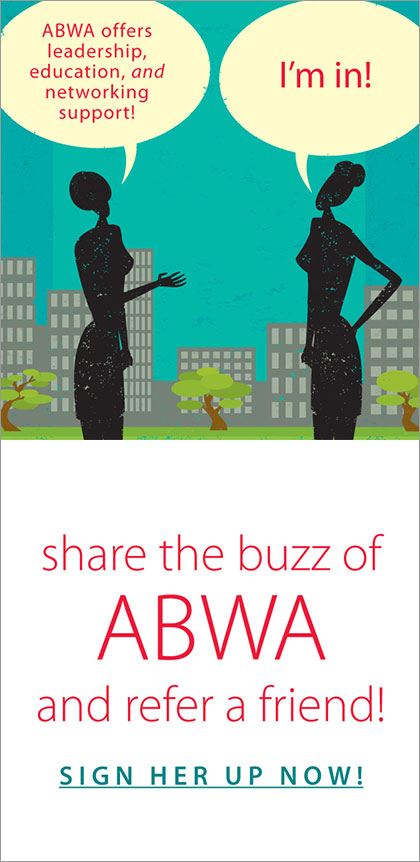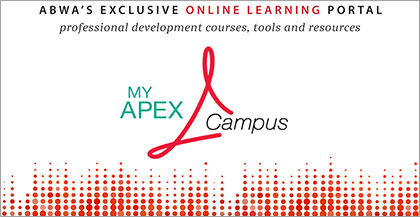
by American Business Women's Association | Feb 14, 2024 | Blog, Business, Uncategorized
To view the complete video, “WHY I JOINED ABWA” – Click the link and/or copy and paste the link into the internet search field: https://youtu.be/iqHYOG_rmcg
About ABWA Member, Dr. Ka’Ryn Holder-Jackson
Dr. Ka’Ryn Holder-Jackson is a dynamic innovative business executive; her expertise is leadership training and development, strategic planning, and organizational development. An articulate, diplomatic, interpersonal communicator with an uncommon ability to influence, motivate, inspire, and communicate with diverse constituents,
A native of San Francisco, she is a graduate of San Francisco State University, where she earned a Bachelor of Science in Psychology, the University of Phoenix, where she earned a Master’s of Business Administration and Capella University where she earned a Doctorate in Human Services.
Ka’Ryn presently serves as the Executive Director of ACCEL San Mateo County Adult Education Consortium where she leads a Ka’Ryn leads a coalition of regional education, training, business and industry partners bridging the gap between employer demand for an educated and skilled workforce and the supply of workers with the necessary skills for a 21st century labor market.
As a former Associate Director for the American Diabetes Association, San Francisco Bay Area, Ka’Ryn received honors as the recipient of a Certificate of Special Congressional Recognition in 2015 from the Honorable Barbara Lee 13th Congressional District of California, In Recognition of Dedication to Educating the Community About Diabetes & the Importance of Health Care.
Ka’Ryn has over 20 years’ experience serving in Executive Management in corporate, for profit, not-for-profit, non-profit, and education Sectors. She is the CEO of A’Ryze Consulting; a Certified Executive Coach, Speaker, Trainer, Corporate Facilitator, and has over 20 years’ experience in the financial services industry and is a licensed financial services representative.
Awards & Recognition:
- 2023 Top Ten Business Woman, American Business Women’s Association
- 2019 Woman of Distinction, American Business Women’s Association
- 2018 Commendation Board of Supervisors of San Mateo County, California
for Leadership in our Communities
- 2015 Certificate of Special Congressional Recognition from the Honorable Barbara Lee 13th Congressional District of California, In Recognition of Dedication to Educating the Community About Diabetes & the Importance of Health Care.

by Rene Street | Jan 10, 2024 | Uncategorized
5 Steps To Turn Negative Thoughts Into Positive Actions
Do you have a Negative Nancy (NN) or Toxic Tim (TT) that you’re keeping longer than you should? Would you let them go if you weren’t so short staffed? One Negative Nancy or Toxic Tim infiltrates the whole company and it spreads throughout, affecting everyone.
Think of it like this: You attend a meeting that NN was in. When you leave, you approach Positive Polly and share with Positive Polly, “It’s so frustrating dealing with NN. Why is she still here? All we do is constantly listen to her babble and unhappiness.” Before you know it, you become a Negative Nancy, and Positive Polly sees the impact the original NN has made on you and the team. It only takes one person thinking negatively to bring the whole environment, culture, and team down. In order to help you, Positive Polly shares the following.
You have 60,000 thoughts a day and 80% of them are negative. These come in the form or doubt, worry and stress and are linked to poor attitudes, declining engagement, and poor performance. Most people think they are positive and optimistic, yet negativity shows and they don’t recognize it. In fact, 95% of your thoughts are repetitive. So, all of the negative thoughts keep getting repeated, impacting how you show up, speak out, lead, and live.
Your thoughts are the fundamental foundation of everything you do and everything you don’t do, yet often times you don’t think about them. When was the last time you thought about what you thought about? If you’re like most people you think the same way you’ve always thoughts, resulting in the same behaviors, actions, and results. If you want to change relationships, communication, interactions, your confidence, you must first change how you think. Once you change that, then everything else will change as well.
Here is a five-step process to help you change your thoughts to invoke different actions, behaviors and results and develop a positive work environment.
ONE: Identify – Recognize Your Thoughts. There’s an exercise to help you very specifically identify your negative thoughts. It’s called the Stand up/Sit down exercise. This is a great exercise to do as a team. Have someone read a set of statements. For every statement you agree with, you will move your body. Everyone starts in a stand-up position. For example, if the first statement is “If you’re ever thought you’re not smart enough,” and you agree, you’ll sit down. If you disagree with the statement, you’ll remain as you were. If the next statement is, “If you’ve ever thought you don’t have enough time,” and you agree, you’ll move (either stand up or sit down depending on what you did for the first statement). This repeats for every statement read (there should be about 15 statements read). During this activity, you can expect to hear laughter evoke from your group, as they are moving for most of them, which shows that negative thinking arises without you consciously knowing. And you have a lot more of them than you believe.
TWO: Write It. Once you’ve identified your negative thoughts, it’s important to write them down. Something happens in your brain when you write things down. They tend to become real, and you remember them more. So, when you write down your negative thoughts, you become more mindful when they arise. Follow the rest of the process with just one of your negative thoughts. Once you have mastered one, work on another (you don’t want to overwhelm you or burn you out on doing too many at once).
THREE: Triggers – What are your triggers for your negative thinking? Triggers can be a place, situation, mood, experience, or thing. If you’ve ever had a conversation with someone and walked away saying to yourself, “Why do I even bother,” then you also know a trigger can be a person too. And many times, it is a person. Write down all of your triggers. When you’re aware of your triggers, you can be on the lookout for them. When they come up, as they will, you are armed to not allow the negative thoughts to follow.
FOUR: Reframe – List all the ways to reframe the negative thought. There are two ways to do this reframing. First, you can say the opposite of the negative statement. Instead of staying I’m not a good enough leader, you can say, “I’m an awesome leader.” The second way is to ask questions. For instance, what courses do I need to take to become a better leader, what leadership book should I read to improve my leadership skills or who can mentor me into being a better leader. Your brain is constantly talking to. If you say you’re not a good enough leader, your brain will validate it with all the ways that it’s true. If you say you’re an awesome leader, your brain will validate it with all the ways that it’s true. So, listening to the positive part of your brain will make all the difference in your work and life.
FIVEl Action – Once you have your reframing options, pick one to take action on. Nothing changes until you take action on it. Small action makes a huge difference. If you want to know the best leadership book to read, you may initially think you do not know any, however, your brain can solve that dilemma. It’ll reply with ideas to look up leadership books on Google, put a post on Facebook asking your friends for their recommendations or look up Amazon book reviews. Then it’s time to decide which action you will take (which book to order and order it). Small consistent action is key to eradicating negative thinking.
The more you work through this process the more positive thoughts you have. You’ll soon recognize negative thoughts in others and can help them master their own mindset. You’ll become the Positive Polly and help develop a positive work environment that no one wants to leave.
About the Author:
Jessica Rector, MBA, author of the #1 best-selling “Blaze Your Brain to Extinguish Burnout” and nine other books, helps organizations, leaders, and teams Say Yes to eradicate burnout and enhance mental health. As a burnout trailblazer, her research is used in her consulting and speaking and often shared on her podcast, “The Say Yes Experience.” For how Jessica can help your organization and team, go to www.jessicarector.com

by American Business Women's Association | Nov 21, 2023 | Blog, Business, Business, Uncategorized
3 Ways To Keep Burnout From Spreading Like Wildfire
Burnout is impacting every company, position, and industry. With 90% of the workforce experiencing burnout in the last year, you can no longer afford to ignore this epidemic. It’s affecting teams, leaders, and the whole organization…even you.
Even if you’re not the one in burnout, it still impacts you.
Think of it this way. How do you feel the next morning when you don’t get quality sleep the night before? Grumpy? Groggy? Foggy? Impatient, irritable, unfocused? Lack of sleep impacts your perspective, attitude, how you respond to others, and how you react to situations.
The same thing happens with burnout. It doesn’t stay self-contained.
When a team member, let’s say Burnout Betty, has burnout, it impacts how she leads, communicates, listens, focuses, thinks, interacts, her behaviors, energy, mood and disposition.
It literally impacts everything. When one person is in burnout, it also trickles out to others, because burned out people burn others out.
Even if you don’t have burnout, you’re being impacted by it when someone else does or is on the brink of it. You have the power to do something about it. What can YOU do?
START A DIALOGUE—Begin talking about burnout is the best place to start. Even though burnout is rampant in the workforce, there’s still some stigma around it. People often fear, if they admit they have it, what will others think, do or say. Will my leaders think I can’t do my job? Will they take away responsibilities or will they lose trust in me?
If Burnout Betty (BB) isn’t focused, she becomes distracted, unproductive, and making more errors. She will do the same work multiple times, miss deadlines or forget to meet a client. Those are best case scenarios. BB will easily cut corners leading to cybersecurity attacks, safety issues and possible injuries.
When BB misses deadlines, makes mistakes, or has to redo work, how does that impact you? You might have to stay longer, do some of her work, or maybe your work gets pushed back waiting on her to get her part to you, which means missing dinner with your family, being absent at your kids’ activities, or not meeting your deadlines.
Lean into your storytelling skills. Share your burnout story with BB. When you were in it, what led to burnout in your life, and the strategies you implemented to move past it.
When people are in burnout, they tend to pull away and isolate themselves. When you tell your burnout story, they will start to engage. The more you talk about burnout, the more it reduces this stigma. In the process, you allow others who are experiencing it to not feel alone and to know that someone, somewhere gets it and understands. You create a safe place of compassion and empathy.
This lets others know it’s okay to feel burned out. You can still love your job and be burned out.
CREATE AWARENESS AROUND BURNOUT—Burnout doesn’t discriminate. It’s impacting your people. The more your team knows what to look for and what to do to prevent it, the less likely they will find themselves in it. Develop a keen eye, because you can’t change something you aren’t aware exists.
Since burnout impacts mental health, Burnout Betty is easily frustrated or irritable, making it harder to communicate or interact with her, because others don’t want her mood to affect them. One Burnout Betty, Negative Nancy or Toxic Tim can bring a dynamic team to a halt.
Talking to BB can leave the most positive person in a negative state, because she doesn’t listen or she’s in a bad mood. So, every conversation takes longer than it should, which means less time for you to tend to your daily tasks.
Build a task force of people who want to be the eyes and ears in your organization in regards to burnout. They can gather information, ask questions to BB and other team members, and start creating a strategy to combat this epidemic. Then take the information they gather, and do something now to help them prevent it.
This allows BB to know that she is being heard and understood and that she matters. One of the biggest qualities people want in their company is to know they matter. When BB knows she matters, she feels supported, knowing she will get the help she needs to combat burnout.
Hint: Time off is great, but vacation won’t cure burnout. Once you create awareness around it, share with your people day to day strategies that work to help alleviate burnout.
IMPLEMENT A BURNOUT PROGRAM—This is the key, fundamental element. Talking about it is a great beginning, but it’s imperative to do more. The only way to prevent and address burnout is to be intentional and strategic with it. Workplace wellness programs aren’t enough; 97% of them don’t specifically address or help with burnout, which is also why 80% of employees aren’t actively involved in wellness programs.
As a leader, you have to do your part to help your people with burnout. If you want long term results, your organization MUST implement a continual program (not a one and done) to help people like Burnout Betty with burnout and others to prevent it.
A long-term strategy is where the magic happens with burnout. Burnout is a slow crawl, and working through it is multi-layered. Whether it’s an online course, bootcamp or Train the Trainer certification, burnout training is no longer a “nice to have.” It’s imperative if your company wants to keep their top talent and create a happy, thriving workplace and culture.
The most successful burnout programs have these key components: accountability, support, encouragement, and Q&A.
Burnout doesn’t go away on its own. With most industries incurring staff shortages, it’s up to you, as a leader, to invest in your people if you want to keep them. Since the #1 reason why people leave organizations is due to burnout, it’s a huge opportunity for you to end the burnout epidemic by starting the dialogue, creating awareness and implementing a burnout program in your company. It’s a win-win for everyone. What will you do to help your people end burnout?
About the Author, Jessica Rector
Jessica Rector, MBA, author of the #1 best-selling “Blaze Your Brain to Extinguish Burnout” and nine other books, helps organizations, leaders, and teams Say Yes to eradicate burnout and enhance mental health. As a burnout trailblazer, her research is used in her consulting and speaking and often shared on her podcast, “The Say Yes Experience.” For how Jessica can help your organization and team, go to www.jessicarector.com

by Rene Street | Mar 30, 2023 | Blog, Uncategorized
There’s never a perfect time to pause your day-to-day work and focus on the internal team, but when you do make the effort, the dividends are immediate. Setting aside an hour, a half-day, a two-day retreat or anything you can manage as a team will provide the opportunity to gather together, grow as a team and refill your collective energy tank in order to bust out of service fatigue and return to delivering excellent customer service in every interaction.
Refill the Team’s Energy
Your first step to regaining the capacity to do your work at your fullest potential is to heighten self-awareness and lean into the responsibility that you must refill your tank. Just like a video game avatar who seizes every opportunity to grab more energy for their harrowing journey ahead, you also need to seek out and embrace the chance to replenish yourselves wherever you find it. The good news is there are easy, actionable ways to find and create more energy for yourself and your whole team. It starts with committing to a “Gather and Grow” mentality that brings a team together (virtually or in person) and facilitates the kind of growth that fills your team’s energy tank and returns your business to a thriving state in the marketplace.
This four-step G.R.O.W. process will show you exactly how.
G – Game On!
Gaming at work might not be an intuitive way to encourage your team to spend their time. But gaming on the job is an easy way to bring hearts and minds together in pursuit of your common professional goals. Friendly sales competitions, staff meetings with moments of levity, and experiential outings with your team are all impactful ways to bust out of service fatigue. To take your workplace gaming to the next level, consider uniting over a cooperative strategy that can break the boredom or monotony of a day. You can boost teamwork qualities through games that bring a team around a collective purpose and goal. These types of efforts are shown to reduce stress and help participants cope with work-related fatigue.
R – Rule Reminders
It seems every business needed to adjust rules, policies, and offerings over the last two years to accommodate the global crisis. Process procedures changed for everything from hotel housekeeping to checking out books from your local library! Frequent change without strong internal communication leads to trouble. Making time to “accuracy audit” will help your team find their footing again when it comes to customer instruction.
Conducting an accuracy audit is easier than it sounds, and it’s the perfect agenda for the next time the team gathers together. Does your website match the current offerings? Do all members of the team know the current rules, even if they only work a few hours a week? Is everyone clear on the current processes of your organization internally and externally? Francis Ford Coppola, the famous film director, was once asked what his secret to success is. He answered, “The first thing I do is make sure that everyone is set is making the same movie.” You are the director of your workplace set. Get all the characters on the same page.
O – Optimism
The dedication to sincerely working toward a better tomorrow is imperative for personal and professional growth. That’s not to say that finding the silver lining in every situation is easy. Far from it. However, when a crowd gathers, its members can feed off each other’s attitudes, mindsets, and perceptions, the good and bad vibes quickly dominoing from one person to the next. For example, observe any boat-rocker on staff who starts a rumor laced with a little over-the-top emotion and see how fast the fire spreads ill-will among the team. Disaster!
However, only you can prevent forest fires! Take the time to gather regularly (even if in a virtual format) and stay in positive communication to decrease the chance of an unnecessary negative spark. Strive to provide frequent updates, truthful status reports, and lead by example with your own optimistic attitude.
W – Warm Welcomes
The odds are good that when your team gathers the next time, there will be new faces on board. Don’t underestimate the power of a warm welcome. No one likes the feeling of being the “new kid in school” and your compassion and kindness (regardless of your position at the company) can go a long way to get new staff off to a great start with the team. Remember to share those unwritten rules everyone else knows about (like, “Use any coffee mug except the purple one with the smiley face. That’s Sandy’s and you all know not to touch it.”) Consider assigning a first-week buddy to each new team member to help shave the learning curve and make them feel at more at home.
Making the time to G.R.O.W. (group gaming, rules review, optimistic outlooks, and warm welcomes) will reboot the energy tank of your organization and make sure everyone is busting out of Service Fatigue with full power and a positive outlook.
About the Author, Laurie Guest
A Hall of Fame keynote speaker and author, Laurie Guest, CSP, CPAE, is an authority on customer service excellence. Laurie blends real-life examples and proven action steps for improvement. She is the author of two books and is writing a third on the topic of service fatigue. To learn more or connect with Laurie, visit www.LaurieGuest.com

by American Business Women's Association | Jan 26, 2023 | Blog, Uncategorized
Being on video and watching videos is today’s business norm. A recent survey showed 76% of consumers watched a video before purchasing a product. Social media influencers promote products through video-based storytelling. You login to video meetings daily with prospects and customers.
Since 2005, the year YouTube launched, video has increasingly grown in prevalence, production value, and consumption. Then in 2020 video marketing took a massive leap forward with the pandemic-induced use of video conferencing, podcasts (with video), and livestreams.
Today, YouTube is the most used social platform for research purposes among business-to-business decisions makers with 50.9% of users. And every day more than 300 million people participate in a Zoom meeting.
The reluctant say about video meetings, “It’s not going away.” Strategic leaders, though, say, “Video is how we do business now.”
In today’s business world all video is video content marketing. Zoom is not a phone call with video. Whether it’s a livestream or a self-produced YouTube short, your videos still need to follow a handful of rules.
Positioning
Some marketers consider the word brand to be a four-letter word. The job of marketers and business leaders, they say, is to position a company or product in the market.
The brand becomes how customers define it, and, hopefully, they define it based on your considerable efforts.
The best marketers see this work of positioning to be the first and most important activity. They have learned to be comfortable with discomfort, because good positioning feels limiting. Good positioning is uncomfortably narrow.
It’s a single, narrowly defined target buyer. Your videos—live and recorded—will improve once you know who you are producing them for and what their motivations are.
Differentiation
What makes you different is what gets people’s attention. Not different for different sake, but a viable, propositional difference which appeals to your ideal buyer.
It’s a noisy, messy, and chaotic market. You want to be a brand which means you can charge a premium. If there is nothing to distinguish yourself from the competition, then you’re a commodity and you can only compete on price.
Your differentiation needs to be relevant and clearly expressed on all your video channels, especially video meetings. The first step is to shift responsibility for video meetings from operations to marketing. The next step, especially with a hybrid workforce, is to make sure that everyone who shows up on video is well trained and that their presence represents the value of the brand.
Distribution
Where to post your videos is determined by positioning and differentiation, not trend or fashion. A fishing guide once said, “You’re not fishing unless you have fish under your boat.” Or as Maverick said to Goose in the first Top Gun, “Target rich environment.”
Distribution can include everything from the social media platform (LinkedIn, TikTok) to the video distributor (YouTube, Vimeo) to the livestream platform. It answers what and how of your video content strategy.
Regardless of platform, you want all your videos to do one thing: direct interested parties to your website. There they learn more about you and begin to fall in love with you.
Distribution isn’t a benign decision. It says a lot about who you are and the people you’re trying to reach.
Story
Stories draw prospects in and customers closer. A well-told story engages the right people into a deeper, more meaningful conversation.
The right story you want to tell elevates the customer as hero. It captures your positioning and differentiation. How you will tell your story—written, audible, or visual—will be determined by the platform you choose and the audience you want to reach.
Tiktok is both a genre of video and a distribution platform. The audience consumes video through a spontaneous scroll. How you tell your story on TikTok may not work on LinkedIn.
Additionally, your video meetings, podcasts, and livestream productions express the story of your brand. The way you show up on video tells a story. But is it the right story? Your video meetings and podcast presence need to set the tone and timbre of future engagements.
Surprise
Better video is an act of kindness. Do everything you can to be more present across the lens.
We all spend enough time in front of a camera. When you show up on camera with a better-than-expected presence, you surprise people. Surprise is one ingredient in being unforgettable.
When you are not present, people check out. When you are present, people respond. Presence is what you say before you say a word.
Your presence should communicate confidence, power, and credibility. This will surprise some people. When combined with confidence, you’ll be more persuasive.
Conclusion
Video content is a critical component to your digital content marketing strategy. All video—whether meetings, podcasts, e-learning, or social media—deserve careful review and attention.
Video is a powerful and compelling medium. These five rules provide the framework you need to begin to evaluate what you’ve already produced and what you plan to produce.
Say to yourself, “Video is how we do business now.” Go and do it!
About the Author
Patrick McGowan, MBA, consults, trains, and coaches business executives and teams to have more power, presence, and credibility on-camera in a video-first market. He pulls together three-decades in marketing, innovation, and leadership. McGowan started Punchn to address the challenges and insecurities we all face when on camera. He is the author of “Across the Lens: How Your Zoom Presence Will Make or Break Your Success.”

by American Business Women's Association | Oct 14, 2022 | Blog, Uncategorized
No single person, no matter how intelligent or experienced, can understand everything there is to know about a given job. Questions will come up, and when they do, the individual – whether a software developer, project manager, sales engineer – or any other title, needs to have a handle on the specific support that is needed, and how to ask for it.
With more people working remotely than ever before, this topic is emerging as a persistent issue. This is particularly true in fields like tech, in which teams must understand how to quickly resolve network and other systemic breakdowns and problems. Here are some ideas how to overcome lack of on-the-job support and seek help:
- Be sure to reach out to the right person. Many times, unhelpful or unsupportive people are acting out of lack of knowledge. Before you text, email, or phone, consider if you are contacting the correct individual. This person may have taken a different position in the company and is no longer current on the issues you need. If you require specific examples of what to do, reach out to someone good at providing practical advice – not someone who offers platitudes like, “You’re smart, you’ll figure it out.”
- Understand the support you need and ask for it Make it clear to colleagues and supervisors alike where you need help. Do you need support on a particular problem? Do you require assistance to better understand the project in its entirety? Perhaps you need to just grasp your specific role in it? Maybe you need greater flexibility to make a deadline. What is it, exactly, that you need? It’s not a good idea to assume that people will automatically know. Tell them.
- Set realistic expectations of others. Many times, people are weathering enough challenges of their own to help out. They may not have the time or resources to be as supportive as you’d like them to be. Is it possible you’re asking for too much? This is where realistic expectations come in. Be sure you’re asking for assistance, nothing more. If your requests are excessive, you will need to start giving back before you can expect any support in return.
- Lack of support often means lack of communication. It can prove difficult to obtain the help you need if there is a big gap in communication. An outgoing person may be happy to talk at length about your problem. But if you assimilate information better by watching a video that explains the issue, contact a colleague who will use a platform like this to help. You may not “get” what the other person is saying or the individual you’re asking might not understand your request because of a communication gap.
- Network, network, network. You can never know too many people! If a trusted colleague quits to take another job with another company and you’ve relied on him exclusively, what then? The plain fact is that people move away, retire, etc. As noted earlier, no single person knows everything. A network of trusted friends, coworkers, mentors, and the like can help in areas where help and support may be lacking. A change of perspective may be what you need instead of relying on the same person.
- Finally, be sure you are willing to accept criticism. We all like to give good advice but we are sometimes awful at accepting the advice of others as it forces us to admit our weaknesses. It’s normal for an individual to think they know more than they actually do. Remember, there is a reason you asked for assistance. Don’t take their suggestion personally. Consider if doing what the person advises will help you professionally. If it will, do it!
In conclusion, never assume a colleague, supervisor or manager understands what you are asking. Don’t rely on a single coworker for assistance and be sure to reach out to the person who can address your problem best. Good luck!
About the Author, Susanne Tedrick
Susanne Tedrick is an infrastructure specialist for Azure, Microsoft’s cloud computing platform. In her work, Susanne helps her clients address needs and challenges surrounding cloud adoption, cost optimization and migration. Susanne is the author of the critically acclaimed “Women of Color in Tech” and the upcoming “Innovating For Diversity”. For more information, please visit: www.SusanneTedrick.com.









